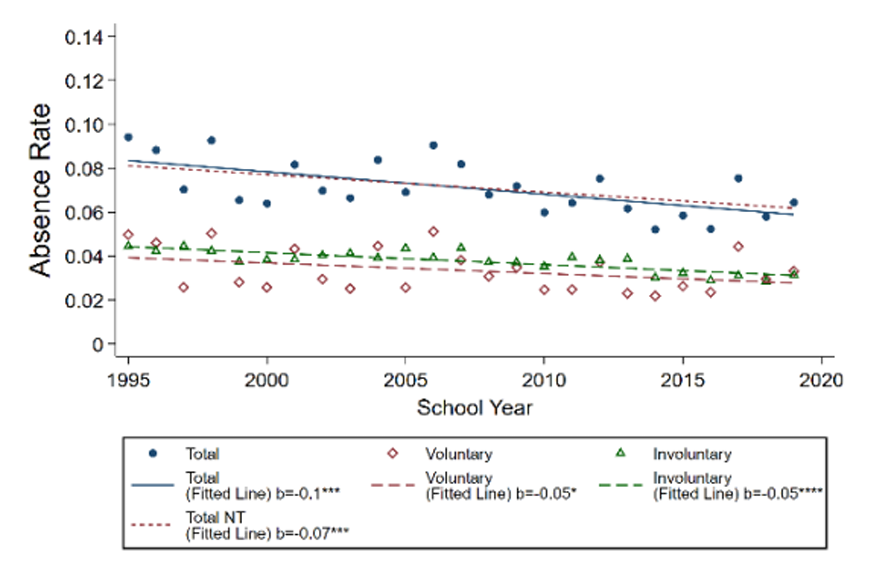Teacher absences have a harmful impact on students—disrupting instruction, reducing instructional quality, and negatively affecting academic outcomes. Absence also risks opportunities to build strong relationships with students. However, a working paper by Rui Wang of Shanghai University and the Annenberg Institute at Brown University reveals the reality of teacher absenteeism doesn't match the myth.
Comparing teacher absences to those of nurses, social workers, and education support workers, the authors find teachers were less likely to be absent and they miss a smaller proportion of working time than other professionals. The data also showed teachers are less likely to take health- or vacation-related absences during the school months than nurses, social workers, or education support workers, suggesting that the lower absence rate isn't just driven by the fact that vacation time is already built into teachers' calendars. This study used data from 1995 to 2019, so the landscape of teacher absences may have shifted post-Covid.
Teachers were also more likely to attend work even when an absence was justified. On the American Time Use Survey Leave Module, 23% of teachers reported showing up for work on days when they needed to take a day off (for illness, for example), compared to 9% of other college-educated professionals. Coming into work when sick has its own repercussions, from spreading germs to negatively impacting classroom management to potential increases in teachers' health problems over the long run.

Note: Teachers' total absence rates decreased from 5.1% in 1994–95 to 3.9% in the 2018–2019 school year. Adapted from "Are Teachers Absent More?" by R. Wang, 2023, EdWorkingPaper, 23:872 (https://edworkingpapers.com/ai23-872).
Researchers found overall that teacher absence rates were declining—from 5.1% in 1994–95 to 3.9% in 2018–19, and rates declined at a faster rate than in other professions. Despite this, 7% of teachers were absent at least once a week, amounting to 4% of weekly work time (since some absences only last part of the school day). Addressing this issue is crucial to ensuring minimal disruption to students. This is similar to what NCTQ found in the past: our 2020 teacher attendance analysis found that teacher attendance had improved since 2014, but 10% of teachers were still chronically absent (i.e., absent at least 18 days).
Mitigation strategies, like wage penalties for absences, are often built around the assumption that teachers need motivation to come into work. However, this study suggests people who enter the teaching profession already exhibit a low tendency for absenteeism (although districts may be well served by tracking teachers who perennially have high absence rates).
Alternative strategies to address the consequences of teacher absences may be more effective, such as improving substitute teacher quality or building a strong student teacher pipeline so that student teachers can act as subs on a limited basis when teachers are out. These steps can allow teachers to take absences when they need to, without compromising students' learning in the process. Further, we need to improve state and district data systems to track teacher absences, report the data in a timely way, and then act accordingly by using staffing strategies to prevent lost time and lost learning for students. Tracking and reporting on teacher absence is especially critical in light of the global pandemic and its impact on students and teachers alike.
